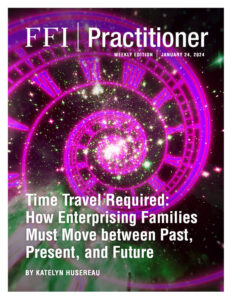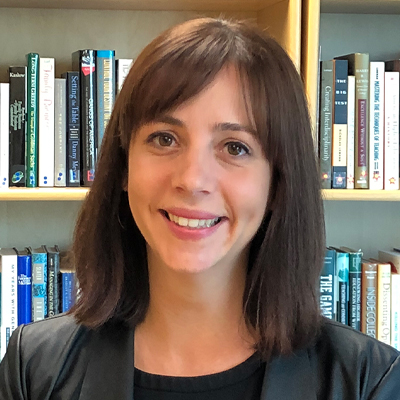
View this edition in our enhanced digital edition format with supporting visual insight and information.
This issue, the third in our January series, is by Katelyn Husereau, a member of the 2024 Conference Program Committee. Her article provides some suggestions on how to work “across time” or “all at once,” and what this approach can mean when advisors are working with several generations of one family.
Family enterprises often (and openly) battle between past and future, wrestling in an unproductive fight that falsely pits “how it’s always been” against “what’s needed now.” The reality is that, in fact, both sides are necessary. Continuity requires integration of the ingredients from both the past and the future to be successful.
This dynamic negotiation of past and future requires families to be time travelers, and we, as advisors, are positioned to help them break the boundaries of time. Tom Gilmore mused on this topic in an article titled “Organizational Learning and the Leadership Skill of Time Travel”1 which centers on the premise that “leaders help organizations perceive possible futures (through the lens of past experiences) to make intelligent decisions in the present.” In other words, the context of the past helps families make decisions today as they look toward the future.
This powerful idea is true for all leaders and is a way to unlock the creativity critical to planning for an unknown future. It is especially relevant to family enterprise leaders, who quite literally must reach from past to future to ensure the continuity of a business, a family, and the values that tie them together. How can we, as practitioners, be helpful guides in the boundary-breaking work of time travel?
Consider the example of a family ownership group I have been working with to help steer their family and the business toward their vision for the future. They identified a goal: business growth to allow for all interested members of their large family to have meaningful roles within the business. When we started the conversation, they all came at the topic of strategy from different angles – Owner 1 believed a deep dive assessment of the past was needed to get them clear about what had worked, Owner 2 wanted to jump ahead and move in bolder ways—pushing beyond the constraints of today, and Owner 3 was worried about having the necessary resources for the realities of operationalizing the current year’s plan. All three approaches were “right,” but because the owners were so set in their positions, they failed to see how working productively with all three views (past, present, future), when explored fully together, could push them further—armed with insights about their greatest competitive advantages.
Practitioners acknowledge that in our work, multiple perspectives can be helpful. So, how to best help families move beyond their perspectives held in line with the boundaries of time—rich history, the current realities, and the future opportunity? Practitioners can simulate a time travel machine that families can board to travel from G1 to G6, two generations in the future. Work with the family to create a fuller picture—a living timeline—of the imagined past and the projected personal, professional, industry, and family events to help the family more fully explore choices along the dimensions of time:
Past: Venturing Back in History to Learn New Lessons
To the families open to such reflection, looking through the lens of history and legacy can offer an opportunity to dialogue, debate, and reconcile. By unpacking the reasons behind past decisions, it’s possible to invite a new dialogue about what can be learned, what can be avoided, and what can be applied. This is not easy work, which makes building the practice important for families. In the best cases, and where the opportunity lies in our work, reflection supports the conditions for more clarity and understanding of the past as a foundation from which to build.
Futures: Leap Out and Imagine Possible Opportunities
It is hard to leap out to the future, when there is more at risk, more unknowns, and more to debate. Yet doing so unlocks creative thinking. Family enterprises with a long-term view have the ability to harness their informed imagination through exploration of multiple scenarios for the future. We often utilize tools with which families can imagine a few alternative scenarios for the future. These thought exercises are not necessarily linear and can help families reconsider traditional and habitual thinking, which can in turn prompt bold and creative ideas. We outline a few possible futures that, while unlikely to be actualized entirely, provide an opportunity for the family to “try on” different states. Intellectual and emotional reactions to those scenarios provide a family with guiding principles for the future.
Present: Returning to the Current Reality
With both an aligned sense of the historical context and some scenarios for the future, families can combine those views to inform the decision-making for the present. Generating this textured view along the dimensions of time (past, present, future) can propel families forward differently, helping them move more confidently—toward less incremental, more fully informed strategic decisions that push the enterprise forward into a bolder future, with more open avenues creating the opportunity to perpetuate the family legacy and advance toward a shared and fulfilling future.
For clients, the need for time travel will not go away once they map out their next chapter. They will need to move continuously back and forth among the past, present, and future as they advance their enterprise for the next 80 years. As they gain their time traveler sea legs, making strategic choices will come with greater insights and confidence. Whether channeling Dr. Who, Marty McFly, or Harry Potter, their time travel won’t have to rely on a magical time-turner. It will have a more solid foundation, derived from a deeper historical family and business context and a team armed with the confidence to make choices—without a full picture of the future but clear on how to navigate the competition, ambiguity, and disruption.
1 Gilmore and Shea, “Organizational Learning,” 84.
References
Gilmore, Thomas N., and Gregory P. Shea. “Organizational Learning and the Leadership Skill of Time Travel.” Journal of Management Development 16, no. 4 (1997): 84–93.
About the Contributor

Katelyn Husereau, ACFWA, is Senior Manager in CFAR’s Family Enterprise and Owner-Led Business and Higher Education practices. She is an expert in next generation development and in understanding how relationships and data combine to drive meaningful outcomes. Before joining CFAR, Katelyn was the Assistant Director of the Center for Family Business at Northeastern University. She can be reached at [email protected].

View this edition in our enhanced digital edition format with supporting visual insight and information.





